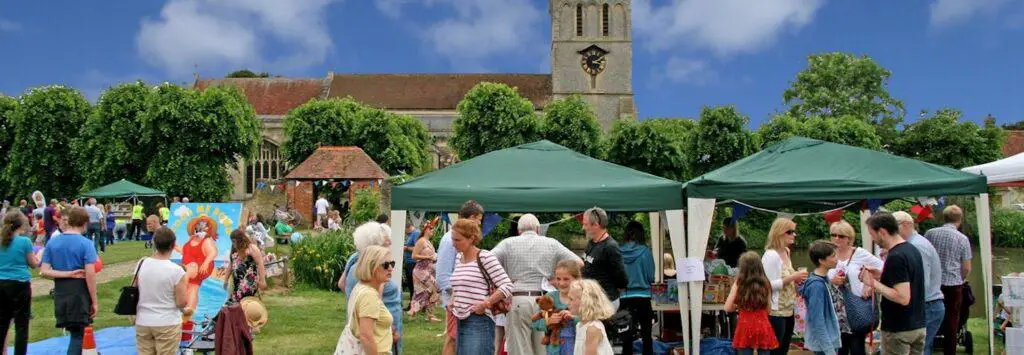Village fetes are a quintessentially British experience; there is no better way to enjoy summer than to wander around the country lanes of the UK, soaking up the sights and sounds as our beautiful towns and villages come together for a celebration of local life.
For one day only, the open grassy fields are transformed into a hubbub of activity as families, friends and passers-by set up stalls selling homemade food, delicious cakes and beautiful gifts, all for a great cause.
Village fetes are as British as roast beef and Yorkshire pudding, strawberries and cream at Wimbledon, fresh scones with jam and cream — a special British tradition.
Fetes are essential to community cohesion, fund raising, and bringing people together. They were historically a working man’s day off and a chance for your whole family to have fun.
Nowadays, many fetes have moved from the old village green or cricket pitch to an open school field or other venue.
Village fetes appear to be enjoying a revival after being in decline for some years.
If you try to imagine a village fete, you will probably conjure up an image in your mind of green grass, brightly coloured stalls, decorations, games, activities, loads of food & drink, some competition, and good old-fashioned fun.
A village fete is an amalgamation of enterprise, charity and community spirit, a fun way for the whole family and all generations to spend a few hours, and a tradition preserved over centuries to keep the British culture alive and well.
Read on to find out a village fete’s history, purpose, and more.
What is a Village Fete?
The word ‘fete’ comes from French, meaning ‘to celebrate.’ However, the village fetes were much more than just a celebration. They were about the community meeting together and bonding.

Although they have their roots in the rural English culture (hence the term ‘village’), fetes became more popular in the 1920s and ’30s and spread to small towns.
Most churches and schools, even in the city, would have a summer fete to raise funds and reach out to the community.
A great part of Great British culture, the annual fete was at the essential heart of village life for years. In addition to being depicted in paintings, village fetes have made appearances in books and movies such as Agatha Christie mysteries and stories by P G Wodehouse.
While the fete culture was at its peak during the 1950s, it dwindled later on as the village community structure shifted, only to be hailed again recently in the form of revived modern fetes.
Modern fetes are an effort to revive the community spirit. The forerunners of the trend are parents and teachers who miss the fun they had in their childhood. They want the new generation to enjoy it afresh.
What’s the Difference Between a Fete and a Fair?
Village fetes have often been confused with fairs. However, the two are different in certain ways. For example, while fairs belonged to mediaeval times in Britain, fetes are relatively new.
Similarly, the purpose of fairs was traditionally to hire men and buy and sell stock. Fairs of such nature are almost extinct now. The few counties that still hold these do it in the form of agricultural shows.
On the contrary, village fetes are much more gentile affairs. Their original purpose was to raise funds.
The only sales perspective to be found in the traditional fetes was parish ladies selling homemade products and produce for a charitable cause like supporting orphans or funding schools and hospitals.
Nowadays, most people think of a ‘fair’ as being a funfair. While professional funfairs do still travel from village to village, these are now much in decline. Up until the 1980s, it was a common site to see them on village greens.
What is the Purpose of Organising a Fete?
Village fetes are a great way to celebrate, connect with and support a community. They’re a chance to address social issues and raise funds for local causes and projects. If planned well they can be very successful.
A village fete is a great way to bring a local community together, it can help local people celebrate their heritage and tradition.
The 21st century is all about work and rushing around. A community needs time to socialise and have fun.
Fetes help us teach our children about games such as coconut shy, hooplas, guess how many jelly beans in the jar, splat the rat and many more well known side-stall games that were played years ago by even our grandparents.
Fetes would traditionally be held annually because it was an expected part of village and/or church life. Most are held in the month of June because of the good weather.
While they would seek to fundraise for a good cause, it was as much about the fun experience of taking part and offering a service to the local community.
Moreover, since these events are organised by community members, it gives everyone a chance to utilise their skills, feel useful and give back to the community.
Fetes may be arranged for different fundraising causes. For example, a church fete is organised either in the church grounds or vicarage with the purpose to get funds for the maintenance of the church, commonly its roof.
On the other hand, residential communities hold fetes to fund the household and area repairs and maintenance. Other types of fetes include school fetes.
Summer Fete Meaning
The term summer fete, village fete and School fete can be used interchangeably. Its simply a festive event held during the warm summer months, typically featuring a variety of outdoor games, entertainment, food stalls, and fundraising activities.
The purpose of a summer fete is to bring together a community to celebrate and enjoy leisurely activities, while often raising funds for local organizations or causes.
While all three types of fetes share the common goal of fostering community spirit and enjoyment, their primary difference lies in the specific community they cater to and the organizations they support.

Church Fete Meaning
A church fete is a festive event organized by a religious community, typically held on church grounds or nearby.
It features games, entertainment, and food stalls to bring together congregation members and raise funds for church-related causes, such as maintenance or charitable endeavors. The primary focus is fostering unity and fellowship among the church community.

Annual Fete Meaning
An annual fete is a recurring festive event held once a year, often celebrating a specific occasion or tradition. It features various activities such as games, entertainment, and food stalls to bring together a community.
The purpose is to foster camaraderie, maintain traditions, and sometimes raise funds for local organizations or causes.
What Makes Village Fetes Special?
Despite some tweaking, even modern village fetes essentially have the same flavour as they did in the 1960s and 1970s. They have a retro throwback quality.
Adults feel nostalgic remembering their youth and a new generation of children discover ways to have fun that don’t involve an electronic device.
Traditional; games such as Hoopla, the Coconut Shy, and Pin the Tail on the Donkey have been around for years and are still loved by everyone. It is their simplicity that is their charm.
A village fete is a social occasion that brings together the whole community – even the village idiot!. The vibrant atmosphere and sense of fun, entertainment and involvement makes them very special and memorable.
Village fetes are fun, cheap and rewarding with something for young and old. That’s why people love them so much.



